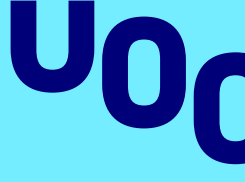
An R&D&i Project from UOC presented at the First Spin UOC Event
Last 13th of June 2013, the first Spin UoC event was held at the old Estrella Damm Factory in Barcelona. Various R&D&i projects from Universitat Oberta de Catalunya (UOC) with a high economic and social potential were presented therein.
At this event, Pere Tuset-Peiró, PhD Candidate at the Internet Interdisciplinary Institute (IN3) of UOC and supervised by Dr. Xavier Vilajosana, both researchers at the Distributed, Parallel and Collaborative Systems (DPCS) Group, had the opportunity to present part of his work carried out since the beginning of 2013 in collaboration with UOC, UPC (Universitat Politècnica de Catalunya) and the CTTC (Centre Tecnològic de Telecomunicacions de Catalunya).
The research work is based on a technique known as Distributed Queuing (DQ) that will surpass some of the limitations of current telecommunications systems that may harm or slow down the success of the Internet of Things. In particular, the availability of communication networks in the presence of massive deployment of devices. Before diving into more detail, let us have a look at the context.
Available wireless communication systems today are unable to provide access when a huge number of devices are located in a close area and must share a common transmission medium. Communication protocols suffer from congestion when the number of simultaneous devices is very high, thus blocking access to new users. This would be equivalent to a traffic jam where a high number of cars try to use the same road and not even an efficient traffic controller is able to find a solution. Just as an example, think of big congregations of people such as cultural or sports events where either cellular or WiFi hot-spots are unable to provide service. While this limitation can become unpleased for human beings, it becomes a dramatic hurdle when it comes to bringing to reality the paradigm of the Internet of Things, where every single object is envisioned to be "connected". If such paradigm is made possible, then a new horizon of smart applications opens in front of us; smart-cities, smart-grids, smart-everything. The question is: is there any solution to this challenge?
The answer is firm and clear: yes. And this is the driving motivation for some research groups around the globe, among which we would like to point out the existing collaboration between UOC, UPC and CTTC. Even though the three Catalan institutions have been working on the topic since long time ago, it has been since the beginning of this year 2013, when the efforts have been aligned and formalized together. More specifically, this has been formalized via a 5-month internship carried out by Pere Tuset at CTTC, from January to May 2013, under the supervision of Dr. Jesus Alonso-Zarate, head of the M2M Communications Department at CTTC, to work together with Dr. Luis Alonso, Associate Professor at UPC, Francisco Vázquez, senior researcher at CTTC, and Oriol Bardina, Bachelor's student at UPC.
The solution is called Distributed Queuing (DQ) and it was originally conceived back in the year 1992 when Dr. Graham Campbell, from the Illinois Institute of Technology (USA), presented at the prestigious conference SIGCOMM the first proposal of DQ for applications in Cable TV distribution. Since then, a number of research works in the topic have been carried out, yielding a remarkable number of scientific publications in well-reputed both international journals and technical conferences. All these works have demonstrated the capacity of DQ to be applied to wireless networks and attain a performance very close to the theoretical maximum capacity independently of the number of simultaneous contending users. Back to the road example, this would mean the solution to make sure that a traffic jam never occurs independently of the number of simultaneous cars. Upon the retirement of Dr. Campbell, all work related to DQ has been focused to date on the research activities carried out jointly at UPC at CTTC, under the coordination of Dr. Luis Alonso. Various PhD Theses have been focused on this topic exploring all details of this promising technology. Till the end of 2012, all the theoretical limits and capacity of DQ have been explored and validated through Math and computer-based simulation. However, it was necessary to check that all these theoretical principles could be put into practice in the real world when applied to actual communication systems.
Prototypes
Through the joint collaboration between UOC-UPC-CTTC, the team has worked towards the development of a DQ prototype based on two re-configurable platforms based on two different technologies. The first one was publicly presented for the first time at the Spin UOC on 13th of June 2013. The results of this prototype are very promising and, even though still some implementation challenges must be solved, initial results show that bringing DQ to reality is viable. Soon, DQ will be ready to reach the market and open doors to numerous applications that will make true the dream of having all objects connected with each other, and connected to the Internet. This will improve the efficiency of numerous businesses, factories, and processes, will help improve human well-being (for example, eHealth applications), and will open frontiers for the definition of new business models and new ways of creating wealth in the impending and unavoidable new era of the Internet of Things.
Xavier Vilajosana, UOC
Pere Tuset-Peiró, UOC
Luis Alonso, UPC
Oriol Bardina, UPC
Jesus Alonso-Zarate, CTTC
Francisco Vázquez-Gallego, CTTC
